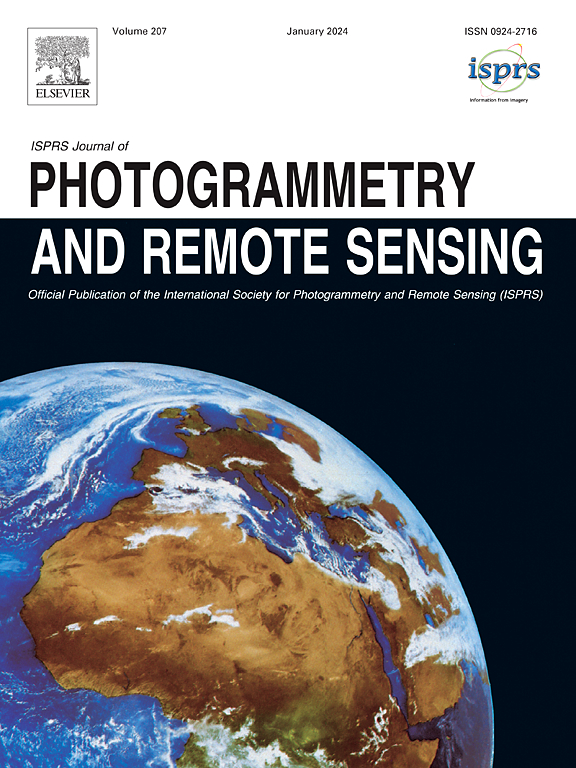LHRS-Bot-Nova: Improved multimodal large language model for remote sensing vision-language interpretation
IF 10.6
1区 地球科学
Q1 GEOGRAPHY, PHYSICAL
ISPRS Journal of Photogrammetry and Remote Sensing
Pub Date : 2025-07-01
DOI:10.1016/j.isprsjprs.2025.06.003
引用次数: 0
Abstract
Automatically and rapidly understanding Earth’s surface is fundamental to our grasp of the living environment and informed decision-making. This underscores the need for a unified system with comprehensive capabilities in analyzing Earth’s surface to address a wide range of human needs. The emergence of multimodal large language models (MLLMs) has great potential in boosting the efficiency and convenience of intelligent Earth observation. These models can engage in human-like conversations, serve as unified platforms for understanding images, follow diverse instructions, and provide insightful feedbacks. In this study, we introduce LHRS-Bot-Nova, an MLLM specialized in understanding remote sensing (RS) images, designed to expertly perform a wide range of RS understanding tasks aligned with human instructions. LHRS-Bot-Nova features an enhanced vision encoder and a novel bridge layer, enabling efficient visual compression and better language-vision alignment. To further enhance RS-oriented vision-language alignment, we propose a large-scale RS image-caption dataset, generated through feature-guided image recaptioning. Additionally, we introduce an instruction dataset specifically designed to improve spatial recognition abilities. Extensive experiments demonstrate superior performance of LHRS-Bot-Nova across various RS image understanding tasks. We also evaluate different MLLM performances in complex RS perception and instruction following using a complicated multi-choice question evaluation benchmark, providing a reliable guide for future model selection and improvement. Data, code, and models will be available at https://github.com/NJU-LHRS/LHRS-Bot.
LHRS-Bot-Nova:用于遥感视觉语言解释的改进多模态大语言模型
自动和快速地了解地球表面是我们掌握生活环境和明智决策的基础。这强调需要一个具有全面分析地球表面能力的统一系统,以满足人类广泛的需求。多模态大语言模型的出现在提高智能地球观测的效率和便利性方面具有巨大的潜力。这些模型可以进行类似人类的对话,作为理解图像的统一平台,遵循不同的指令,并提供有洞察力的反馈。在这项研究中,我们介绍了lrs - bot - nova,一个专门用于理解遥感(RS)图像的MLLM,旨在熟练地执行与人类指令一致的广泛的RS理解任务。LHRS-Bot-Nova具有增强的视觉编码器和新颖的桥接层,可实现高效的视觉压缩和更好的语言视觉对齐。为了进一步增强面向RS的视觉语言对齐,我们提出了一个大规模的RS图像标题数据集,该数据集通过特征引导的图像再捕获生成。此外,我们还引入了一个专门用于提高空间识别能力的指令数据集。大量的实验证明了lrs - bot - nova在各种遥感图像理解任务中的优越性能。我们还使用一个复杂的选择题评估基准来评估不同的MLLM在复杂RS感知和指导下的表现,为未来模型的选择和改进提供可靠的指导。数据、代码和模型可在https://github.com/NJU-LHRS/LHRS-Bot上获得。
本文章由计算机程序翻译,如有差异,请以英文原文为准。
求助全文
约1分钟内获得全文
求助全文
来源期刊

ISPRS Journal of Photogrammetry and Remote Sensing
工程技术-成像科学与照相技术
CiteScore
21.00
自引率
6.30%
发文量
273
审稿时长
40 days
期刊介绍:
The ISPRS Journal of Photogrammetry and Remote Sensing (P&RS) serves as the official journal of the International Society for Photogrammetry and Remote Sensing (ISPRS). It acts as a platform for scientists and professionals worldwide who are involved in various disciplines that utilize photogrammetry, remote sensing, spatial information systems, computer vision, and related fields. The journal aims to facilitate communication and dissemination of advancements in these disciplines, while also acting as a comprehensive source of reference and archive.
P&RS endeavors to publish high-quality, peer-reviewed research papers that are preferably original and have not been published before. These papers can cover scientific/research, technological development, or application/practical aspects. Additionally, the journal welcomes papers that are based on presentations from ISPRS meetings, as long as they are considered significant contributions to the aforementioned fields.
In particular, P&RS encourages the submission of papers that are of broad scientific interest, showcase innovative applications (especially in emerging fields), have an interdisciplinary focus, discuss topics that have received limited attention in P&RS or related journals, or explore new directions in scientific or professional realms. It is preferred that theoretical papers include practical applications, while papers focusing on systems and applications should include a theoretical background.
 求助内容:
求助内容: 应助结果提醒方式:
应助结果提醒方式:


